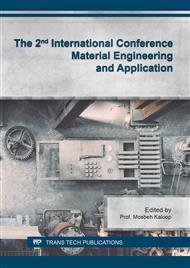[1]
Q. Xue, Q. Wang, Wear mechanisms of polyetheretherketone composite filled with various kinds of SiC, Wear 213 (1997) 54–58.
DOI: 10.1016/s0043-1648(97)00178-6
Google Scholar
[2]
X. S. Xing, R. K. Y. Li, Wear behavior of epoxy matrix composites filled with uniform sized sub-micron spherical silica particles, Wear 256 (2004) 21–26.
DOI: 10.1016/s0043-1648(03)00220-5
Google Scholar
[3]
M. Z. Rong, M. Q. Zhang, H. Liu, H. M. Zeng, B. Wetzel, K. Friedrich, Microstructure and tribological behavior of polymetric nanocomposites, Ind. Lub. Tri. 53 (2001) 72–77.
DOI: 10.1108/00368790110383993
Google Scholar
[4]
K. Friedrich, Particulate dental composites under sliding wear conditions, J. Mater. Sci.: Mater. Med. 4 (1993) 266–272.
DOI: 10.1007/bf00122279
Google Scholar
[5]
S. Guang, M. Q. Zhang, M. Z. Rong, B. Wetzel, K. Friedrich, Friction and wear of low nanometer Si3N4 filled epoxy composites, Wear 254 (2003) 784–796.
DOI: 10.1016/s0043-1648(03)00190-x
Google Scholar
[6]
S. Guang, M. Q. Zhang, M. Z. Rong, B. Wetzel, K. Friedrich, Sliding wear behavior of epoxy containing nano-Al2O3 particles with different pretreatments, Wear 256 (2004) 1072–1081.
DOI: 10.1016/s0043-1648(03)00533-7
Google Scholar
[7]
S. Bahadur, C. Sunkara, Effect of transfer film structure, composition and bonding on the tribological behavior of polyphenylene sulfide filled with nano particles of TiO2, ZnO, CuO and SiC, Wear 258 (2005) 1411–1421.
DOI: 10.1016/j.wear.2004.08.009
Google Scholar
[8]
C. K. Lam, K. T. Lau, Tribological behavior of nanoclay/epoxy composites, Mater. Lett. 61 (2007) 3863–3866.
DOI: 10.1016/j.matlet.2006.12.078
Google Scholar
[9]
K. Friedrich, R. Walter, H. Voss, J. Karger-Kocsis, Effect of short fiber reinforcement on fatigue crack propagation and fracture of PEEK matrix composites, Comp. 17 (1986) 205–216.
DOI: 10.1016/0010-4361(86)91004-9
Google Scholar
[10]
J. Karger-Kocsis, K. Friedrich, Effect of temperature and strain rate on fracture toughness of PEEK and its short glass fiber composites, Polym. 27 (1986) 1753–1760.
DOI: 10.1016/0032-3861(86)90272-7
Google Scholar
[11]
B. Wetzel, F. Haupert, K. Friedrich, M. Q. Zhang, M. Z. Rong, Impact and wear resistance of polymer nanocomposites at low filler content, Pol. Eng. Sci. 42 (2002) 1919–(1927).
DOI: 10.1002/pen.11084
Google Scholar
[12]
Q. B. Guo, K. T. Lau, M. Z. Rong, M. Q. Zhang, Optimization of tribological and mechanical properties of epoxy through hybrid filling, Wear 269 (2010) 13–20.
DOI: 10.1016/j.wear.2010.03.001
Google Scholar
[13]
A. J. Kinloch, R. Mohammed, A. Taylor, C. Eger, S. Sprenger, D. Egan, The effect of silica nano-particles and rubber particles on the toughness of multiphase thermosetting epoxy polymers, J. Mater. Sci. 40 (2015) 5083-5086.
DOI: 10.1007/s10853-005-1716-2
Google Scholar
[14]
K. Friedrich, Erosive wear of polymer surfaces by steel ball blasting, J. Mater. Sci. 21 (1986) 3317–3332.
DOI: 10.1007/bf00553375
Google Scholar
[15]
M. H. Cho, S. Bahadur, Study of the tribological synergistic effects in nano CuO filled and fiber reinforced polyphenylene sulfide composites, Wear 258 (2005) 835–845.
DOI: 10.1016/j.wear.2004.09.055
Google Scholar
[16]
Y. L. Liang, R. A. Pearson, The toughening mechanism in hybrid epoxy–rubber nano-composites (HESRNs), Pol. 51 (2010) 4880-4890.
DOI: 10.1016/j.polymer.2010.08.052
Google Scholar
[17]
Q. Wang, Q. Xue, W. Shen, The friction and wear properties of nanometre SiO2 filled polyetheretherketone, Tribo. Inter. 17(30) (1997) 193-197.
DOI: 10.1016/s0301-679x(96)00042-4
Google Scholar
[18]
C. Gao, G. Zhang, T. Wang, Q. Wang, Enhancing the tribological performance of PEEK exposed to water-lubrication by filling goethite (α-FeOOH) nanoparticles, R. Soc. Chem. Adv. 6 (2016) 51247-51256.
DOI: 10.1039/c6ra06904e
Google Scholar
[19]
L. Chang, K. Friedrich, L. Ye, Study on the transfer film layer in sliding contact between polymer composites and steel disks using nanoindentation, J. Trib. 136 (2014) 1-12.
DOI: 10.1115/1.4026174
Google Scholar
[20]
S. Bahadur, D. Gong, The role of copper compounds as fillers in the transfer and wear behavior of polyetheretherketone, Wear 154 (1992) 151-165.
DOI: 10.1016/0043-1648(92)90251-3
Google Scholar
[21]
ASM Handbook Volume 8: Mechanical Testing and Evaluation, Ed. H. Kuhn and D. Medlin ASM International, New York, (2000).
Google Scholar
[22]
Z. Zhang, C. Breidt, L. Chang, K. Friedrich, Wear of PEEK composites related to their mechanical performances, Tribo. Inter. 37 (2004) 271–277.
DOI: 10.1016/j.triboint.2003.09.005
Google Scholar
[23]
G. T. Wang, On fracture toughness and fatigue resistance of polymer/nanoparticle composites, Phd thesis, The University of Sydney (2010).
Google Scholar
[24]
J. C. Halpin, J. L. Kardos, The Halpin–Tsai equations – a review, Pol. Eng. Sci. 16(5) (1976) 344-352.
DOI: 10.1002/pen.760160512
Google Scholar


